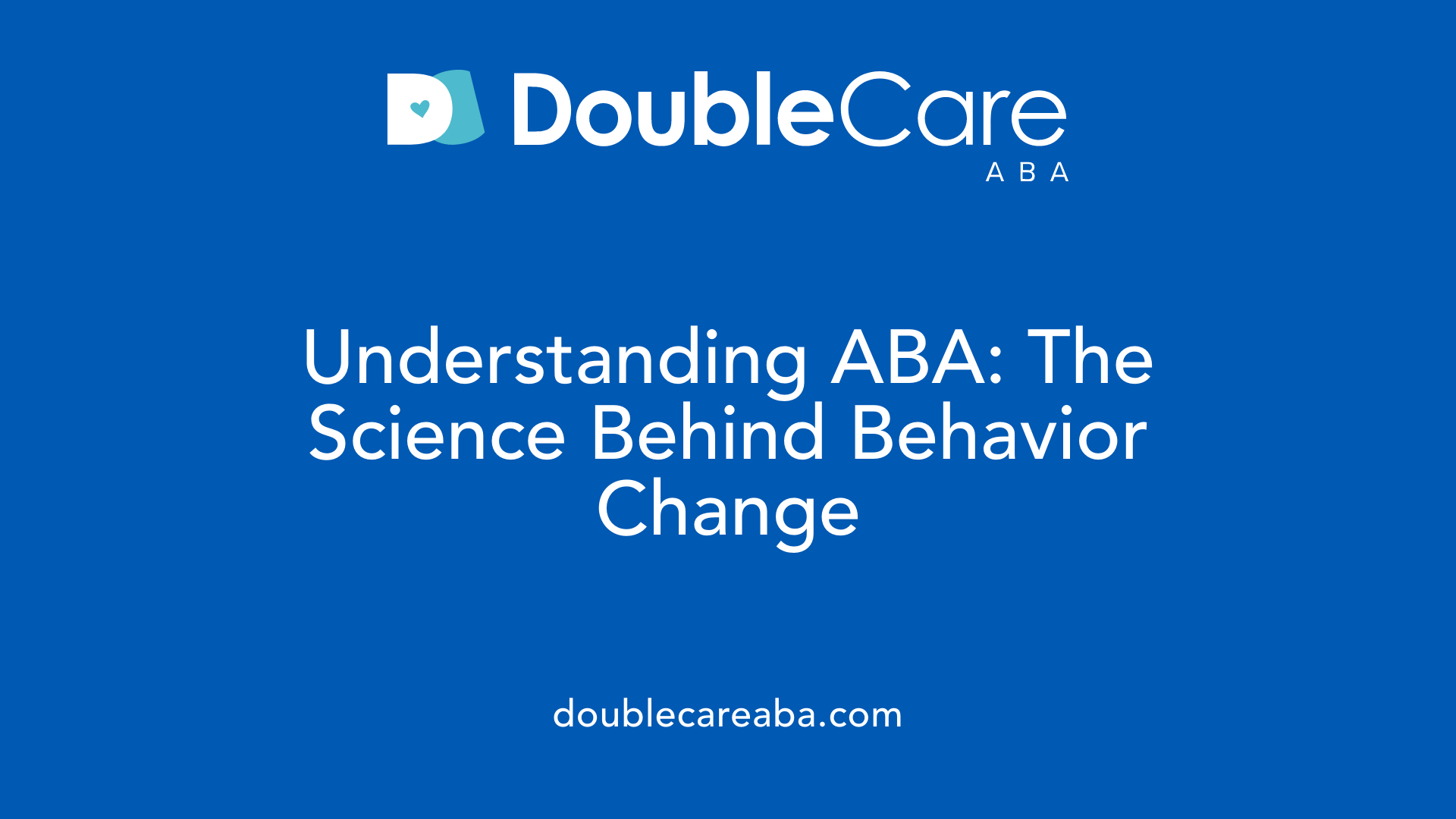Exploring Nonverbal Autism and Therapeutic Approaches
Nonverbal autism presents unique challenges, particularly in communication and behavior. Various therapeutic approaches, especially Applied Behavior Analysis (ABA), provide tailored strategies to support individuals with nonverbal autism. This article delves into ABA therapy's role, techniques, effectiveness, and providers, alongside complementary interventions aimed at fostering communication, social skills, and independence.
What is Applied Behavior Analysis (ABA) Therapy and Its Role in Nonverbal Autism?

What is Applied Behavior Analysis (ABA) therapy and how does it help individuals with autism?
Applied Behavior Analysis (ABA) therapy is a science-based method that focuses on understanding and changing behavior by analyzing the relationship between environmental factors and an individual’s actions. It is widely used to support individuals with autism, including those who are nonverbal, by promoting skills needed for communication, social interaction, and everyday independence.
How does ABA increase helpful behaviors and reduce challenging behaviors?
ABA works by encouraging positive behaviors through strategies like positive reinforcement, where desirable actions are rewarded with meaningful incentives such as praise or preferred activities. At the same time, it aims to reduce challenging behaviors by examining their causes and modifying the environment or teaching alternative behaviors that serve the same function.
What role do individualized treatment plans and BCBAs play?
Each ABA program is tailored specifically to the individual’s abilities, age, and needs. These plans are developed and monitored by a Board-Certified Behavior Analyst (BCBA), who ensures the therapy goals focus on vital skills such as communication, social skills, self-care, and learning. Progress is carefully tracked through systematic data collection during therapy sessions.
What does research say about ABA's effectiveness?
ABA is recognized by authoritative bodies like the US Surgeon General and the American Psychological Association as an evidence-based best practice for autism intervention. Over 20 studies demonstrate its success in enhancing language, social behaviors, focus, academic performance, and reducing problematic behaviors.
Why is early and intensive ABA intervention important?
Starting ABA therapy early, especially in children under 5, allows for maximal developmental gains. Intensive, consistent intervention helps children develop critical skills during a period when the brain is most adaptable, leading to better long-term outcomes.
ABA therapy offers a structured, proven approach that can significantly improve quality of life for nonverbal children with autism by fostering communication abilities, social interaction, and reducing behaviors that interfere with learning and daily living.
Who Delivers ABA Therapy? Qualifications and Roles of Providers

Roles of BCBAs, BCaBAs, and Behavioral Technicians
Applied Behavior Analysis (ABA) therapy is delivered by a team of professionals, each with defined roles to ensure effective treatment. The primary providers are Board Certified Behavior Analysts (BCBAs), who are responsible for creating, implementing, and adjusting individualized treatment plans. They oversee the therapy process and train other team members. Assistant Behavior Analysts (BCaBAs) support BCBAs by helping to carry out intervention programs under supervision. Behavioral technicians or therapists are the frontline practitioners who work directly with clients to apply ABA methods in daily sessions.
Educational Background Required
To qualify as a BCBA, an individual typically must have a master's degree in behavior analysis, psychology, education, or a related field, combined with supervised fieldwork and successful completion of a certification exam. BCaBAs usually hold at least a bachelor's degree and have training in ABA principles. Behavioral technicians often receive specific ABA training post-secondary education but do not require certifications as extensive as BCBAs or BCaBAs.
Supervision and Ongoing Training Importance
Ongoing supervision and continuous professional development are vital in ABA therapy to maintain the quality and ethical standards of care. BCBAs supervise BCaBAs and behavioral technicians, ensuring that interventions remain evidence-based and tailored to the individual's evolving needs. Regular training updates keep providers informed about the latest research and techniques.
Ensuring Quality Care Through Provider Credentials and Experience
When choosing ABA therapy providers, families should verify credentials such as BCBA or BCaBA certification and consider the provider's experience with autism spectrum disorder and related conditions. A provider’s expertise in designing personalized programs and data-driven monitoring enhances therapy effectiveness. Transparent communication and collaborative care also contribute to high-quality services.
| Provider Type | Educational Requirements | Main Responsibilities |
|---|---|---|
| BCBA | Master's degree + certification | Program design, supervision, treatment modification |
| BCaBA | Bachelor's degree + certification | Assist with treatment delivery under BCBA supervision |
| Behavioral Technician | ABA training | Direct therapy implementation with clients |
Tailoring ABA Therapy for Individuals with Nonverbal Autism

How is ABA therapy tailored to meet individual needs in autism treatment?
ABA therapy begins with comprehensive assessments to identify the unique strengths, challenges, and specific needs of each individual, especially for those with nonverbal autism. These assessments guide the creation of customized treatment plans targeting crucial behaviors and developmental skills like communication, social interaction, and self-care.
Customized Treatment Plans Targeting Behaviors and Skills
The treatment plans are carefully adapted not only to the individual's abilities but also to their daily environment, such as home or school settings. This adaptation helps create a comfortable learning context that reduces anxiety and supports natural skill acquisition.
Family Involvement and Skills Generalization
Family members are actively involved as partners in the therapy process, playing a vital role in helping the individual generalize skills across different environments. This involvement ensures that learned behaviors transfer from therapy sessions to everyday routines, fostering consistency and long-term success.
Flexible and Personalized Approaches Based on Learning Styles
ABA uses flexible techniques personalized to the individual's preferred learning methods and motivations. Strategies may include visual supports, positive reinforcement, and step-by-step teaching methods like discrete trial training (DTT) or pivotal response treatment (PRT) adapted to fit nonverbal communication styles.
Ongoing Evaluation and Collaboration
Continuous data collection and evaluation allow therapists to monitor progress closely and make data-driven adjustments. Collaboration among behavior analysts, families, educators, and healthcare providers ensures that therapy remains relevant, effective, and responsive to changing needs.
This highly individualized approach in ABA therapy leads to improved outcomes by addressing the specific behavioral and developmental challenges of nonverbal individuals with autism, ultimately enhancing their quality of life.
Key ABA Techniques Used to Support Nonverbal Children
What are some common techniques used in ABA therapy?
ABA therapy utilizes a variety of strategies to promote behavioral improvements, especially for nonverbal children with autism.
Positive reinforcement and meaningful rewards play a crucial role by encouraging desired behaviors. These rewards can include praise, favorite toys, or access to preferred activities, making the behavior more likely to recur.
Discrete Trial Training (DTT) employs step-by-step instruction, breaking complex skills into small, teachable units. Each trial includes a clear instruction, the child's response, and a consequence like a reward or correction.
Natural Environment Teaching (NET) focuses on learning within everyday settings, utilizing natural interactions to build social and communication skills in familiar contexts.
Modeling and video modeling help children observe and imitate behaviors. While traditional modeling involves a person demonstrating the behavior, video modeling uses recorded examples to enhance understanding and engagement.
Prompting and fading are techniques used to guide children toward independence. Prompts might be verbal cues or physical assistance that are gradually reduced as the child gains proficiency.
Task analysis, behavior chaining, and extinction involve breaking down complex activities into smaller steps (task analysis), teaching sequences of behaviors where each step leads to the next (behavior chaining), and systematically reducing unwanted behaviors by withholding reinforcement (extinction).
ABA therapy blends these evidence-based methods tailored to the child's unique needs, fostering meaningful progress in communication, socialization, and independence.
Effectiveness of ABA Therapy for Nonverbal Autism
What scientific evidence supports the efficacy of ABA therapy?
Applied Behavior Analysis (ABA) therapy is recognized as an evidence-based best practice for autism spectrum disorder (ASD). Since the 1960s, over 20 studies have demonstrated its effectiveness, particularly in improving communication, social skills, and adaptive behaviors in children with autism. The U.S. Surgeon General and American Psychological Association endorse ABA as an effective intervention for ASD.
How does ABA therapy improve communication, socialization, and adaptive skills?
ABA uses techniques such as positive reinforcement to encourage desired behaviors, including language development and social interaction. For nonverbal children with autism, ABA can increase communication abilities through methods like discrete trial training (DTT) and naturalistic strategies that promote verbal and nonverbal communication. Social skills, self-care, and emotional regulation also improve as behaviors are shaped and reinforced.
Why is early and intensive intervention important?
Early intervention, ideally starting before age 5, allows children to develop critical skills during a sensitive developmental window. Intensive therapy—often 25 to 40 hours per week—maximizes gains. Research shows that such early and consistent intervention leads to more significant and lasting improvements in functioning.
Does ABA therapy work the same for everyone?
Outcomes vary widely depending on individual factors such as age at therapy onset, severity of symptoms, cognitive abilities, and co-occurring conditions. Therapy quality and customization by skilled Board Certified Behavior Analysts (BCBAs) also impact effectiveness.
What role do family involvement and therapy quality play?
Family participation enhances generalization of skills beyond therapy sessions. Training parents and caregivers to apply ABA strategies consistently is crucial. Quality of therapy—guided by data collection and individualized goal setting—is critical to success.
What is the recommended long-term commitment and therapy duration?
ABA therapy is usually a long-term commitment, spanning several years to maintain and build on progress. Daily or weekly sessions totaling 25 to 40 hours are often recommended during early childhood to achieve optimal outcomes.
This combination of scientific support, individualized approaches, early and intensive application, and family engagement underpins ABA's effectiveness in improving the lives of many children with nonverbal autism.
Integrating Speech and Occupational Therapies for Comprehensive Support
How Does Speech and Language Therapy Support Communication in ASD?
Speech and language therapy plays a crucial role in developing both verbal and nonverbal communication skills in individuals with autism spectrum disorder (ASD). Therapists use various techniques, including augmentative communication methods such as picture exchange systems or devices, to support those with limited speech. Social language skills are also a focus, helping children engage more effectively in conversations and social interactions.
What Is the Role of Occupational Therapy in Promoting Independence?
Occupational therapy centers on helping children develop self-care skills vital for daily living, such as eating, dressing, and bathing. This therapy works on motor skill development to improve coordination and physical abilities. Sensory processing exercises are incorporated to help manage sensory sensitivities common in ASD, enabling better interaction with the environment and enhancing overall independence.
How Can Combining Therapies Enhance Progress?
Combining speech and occupational therapies with Applied Behavior Analysis (ABA) offers a holistic approach to support children with autism. While ABA targets behavior modification and social skill development, speech therapy enhances communication abilities, and occupational therapy develops practical life skills. This integrated strategy can address diverse developmental needs comprehensively, leading to improved outcomes and a better quality of life for the child.
Social-Relational and Psychological Interventions Complementing ABA
What are Relationship Development Intervention (RDI) and DIR/Floor Time?
Relationship Development Intervention (RDI) and DIR/Floor Time are social-relational therapies designed to improve social skills and emotional connections for individuals with autism. RDI focuses on teaching children how to form emotional bonds, manage change, and develop flexible thinking. Parents often serve as primary therapists in RDI, supporting their child's progress in daily life.
DIR/Floor Time encourages children to engage through play and emotional interactions, aiming to foster meaningful social exchanges and developmental growth.
How do social stories and social skills groups help?
Social stories provide clear, simple narratives about social situations, helping children understand and anticipate social interactions. Social skills groups offer a structured environment where children practice communication, sharing, and cooperation with peers, enhancing their social understanding and confidence.
How does Cognitive Behavioral Therapy (CBT) assist with anxiety?
CBT is a structured talk therapy that helps children identify and change negative thought patterns and behaviors that contribute to anxiety and other mental health challenges. By teaching coping strategies and problem-solving skills, CBT supports emotional regulation and resilience.
How do these approaches enhance emotional bonds and social skills?
Social-relational interventions prioritize building strong, responsive relationships, which serve as a foundation for improving social communication and emotional understanding. These therapies work alongside behavioral methods like ABA to create a holistic approach.
What is the role of parent involvement?
In many models, particularly RDI, parents act as primary therapists, embedding therapeutic practices into everyday routines. Their active participation promotes consistency and strengthens the emotional and social growth of their child.
Combining social-relational and psychological therapies with behavioral treatments like ABA offers a comprehensive framework to support diverse developmental needs in children with autism.
Managing Challenging Behaviors: Understanding Context and Prevention
What Triggers Challenging Behaviors in Autism?
Challenging behaviors such as self-injury, aggression, and tantrums in individuals with autism are often linked to difficulties in communication and the surrounding environment. When children cannot express their needs or frustrations verbally, they may use behaviors as a form of communication.
How Does the ABC Model Help in Behavior Analysis?
The ABCs—Antecedent, Behavior, Consequence—are a foundational tool in understanding the context of behaviors. The antecedent is what happens before the behavior, the behavior is the action itself, and the consequence follows the behavior. This pattern helps therapists pinpoint triggers and how responses influence future behaviors.
What Environmental Changes Can Reduce Behavior Triggers?
Altering the environment is a crucial prevention strategy. Techniques include:
- Using visual schedules to provide clear structure
- Implementing timers to signal transitions
- Priming children by previewing upcoming activities
- Offering choices to empower decision-making These modifications decrease anxiety and reduce occurrences of challenging behaviors.
Which Prevention Strategies Are Effective?
Prevention focuses on minimizing triggers. Visual supports and consistent routines help children anticipate what comes next. Providing preferred activities and choices also reduces frustration and empowers the child, leading to fewer behavior challenges.
What Are Replacement Strategies?
Replacement strategies teach alternative ways to communicate and cope. Functional communication training enables children to use words, gestures, or communication devices instead of problematic behaviors. Teaching coping skills, tolerance for delays, and daily living skills bolster independence and reduce reliance on disruptive actions.
How Are Response Strategies Applied?
Response strategies reinforce positive behaviors and diminish negative ones through careful use of reinforcement and extinction techniques. Safety is prioritized while reinforcing desirable behaviors ensures they are repeated. Ignoring or redirecting problem behaviors can help decrease their frequency over time.
This comprehensive approach to behavior management—understanding triggers, modifying environments, preventing escalation, teaching alternatives, and shaping responses—supports improved outcomes for individuals with autism and related challenges.
ABA Therapy Beyond Autism: Versatility and Applications
Use of ABA in ADHD, OCD, ODD, PTSD, and Traumatic Brain Injury
Applied Behavior Analysis (ABA) therapy, while widely known for its effectiveness with autism, has proven beneficial for various other conditions. In children with Attention Deficit Hyperactivity Disorder (ADHD), ABA uses reward systems such as token economies to encourage appropriate social behaviors and help manage impulsivity and hyperactivity. For Obsessive-Compulsive Disorder (OCD), ABA techniques blend with mental health therapies to reduce compulsive behaviors by fostering healthier reactions to negative stimuli.
Children with Oppositional Defiant Disorder (ODD) benefit from ABA through positive reinforcement, which conditions desired behaviors instead of relying on punishment. ABA also aids individuals with Post-Traumatic Stress Disorder (PTSD) by supporting emotional regulation and reducing reactive behaviors linked to traumatic memories. For those recovering from Traumatic Brain Injury (TBI), ABA focuses on behavior modification to improve social skills, decrease aggression, and assist in relearning everyday tasks.
Techniques Adapted for Various Cognitive and Behavioral Conditions
ABA therapy's toolbox includes functional behavior assessment, naturalistic teaching, discrete trial training, pivotal response treatment, social narratives, visual supports, reinforcement strategies, and task analysis. These methods are adaptable across disorders to tailor interventions that address specific behavioral or cognitive challenges. For example, discrete trial training and reinforcement strategies help children develop new skills, while social narratives and visual supports enhance understanding of social situations.
ABA in Rehabilitation Settings for Adults
Beyond children, ABA strategies extend to adult rehabilitation. This includes therapy for individuals with substance abuse problems, dementia, and emotional regulation difficulties. By modifying behaviors and reinforcing positive responses, adults can regain competencies, manage symptoms, and improve daily functioning.
Supporting Emotional Regulation, Social Skills, and Task Relearning
ABA plays a critical role in enhancing emotional regulation by teaching coping skills that reduce maladaptive behaviors. Social skills development is emphasized through structured interaction and reinforcement, enabling individuals to navigate social contexts more effectively. Additionally, ABA facilitates task relearning, particularly in rehabilitation scenarios, by breaking down activities into manageable steps and rewarding progress.
Broad Applicability of ABA Strategies
The versatile nature of ABA allows it to be a robust tool in various behavioral therapy and classroom management settings. Its evidence-based approaches fit diverse populations and challenges, proving that ABA’s impact extends far beyond autism treatment. This adaptability underscores the importance of ABA in both clinical and educational contexts, offering comprehensive support tailored to individual needs.
Accessing ABA Therapy: Insurance, Providers, and Family Considerations

What insurance coverage and Medicaid policies support ABA therapy?
Insurance coverage for Applied Behavior Analysis (ABA) therapy often varies by state and insurance provider. Many insurance plans, particularly Medicaid, cover ABA services when deemed medically necessary, especially for children under the age of 21. This coverage can substantially ease the financial burden on families seeking therapy for autism spectrum disorder. Understanding your specific insurance policy details and Medicaid provisions is the first crucial step to accessing affordable ABA therapy.
How can families find qualified ABA providers?
To obtain effective ABA therapy, families should look for professionals certified as Board Certified Behavior Analysts (BCBAs). These qualified providers develop individualized therapy programs based on thorough assessments, ensuring that interventions meet the child's unique needs. Families can consult with their medical providers for referrals, use online registries, or contact local autism organizations to locate reputable ABA therapists in their area.
What questions should families ask providers to ensure quality care?
Before beginning therapy, families should ask potential ABA providers:
- What certifications and experience do you have working with children with autism?
- How do you individualize treatment plans and monitor progress?
- What is the frequency and duration of therapy sessions?
- How do you involve families in the therapy process?
- What outcomes have you observed in previous clients? Asking these questions helps families select therapists who provide transparent, evidence-based, and collaborative care.
Why is a medical referral and therapy prescription important?
A medical referral or prescription is often required by insurance companies to authorize ABA services. This ensures that ABA therapy is recognized as a medically necessary intervention and helps facilitate insurance claims and coverage. Working closely with pediatricians and other healthcare providers is essential to obtain the necessary documentation for starting therapy.
How does family involvement impact therapy success?
Family participation is vital in coordinating and reinforcing ABA therapy strategies. Caregivers provide crucial input during assessments, help in generalizing skills to daily life, and maintain consistency between therapy sessions and home environments. Collaboration between therapists and families fosters better outcomes, making ABA therapy more effective and meaningful for the child.
| Aspect | Details | Importance |
|---|---|---|
| Insurance & Medicaid | ABA often covered when medically necessary, esp. under 21 | Reduces financial burden, enables access |
| Qualified Providers | BCBA certified, experience with autism | Ensures individualized, evidence-based therapy |
| Family Questions | Certs, plans, progress, involvement, outcomes | Helps choose transparent, effective care |
| Medical Referral | Required for insurance authorization | Necessary for coverage, formal therapy start |
| Family Role | Input, reinforcement, consistency | Improves therapy success through collaboration |
The Path Forward for Nonverbal Autism Support
Nonverbal autism requires multifaceted therapeutic approaches with Applied Behavior Analysis therapy as a cornerstone. ABA's evidence-based, individualized strategies empower children to improve communication and adaptive behaviors. When complemented by speech, occupational, social-relational, and psychological interventions—and supported by families and qualified professionals—ABA contributes significantly to enhancing quality of life. Early, intensive, and consistent intervention maximizes potential, while understanding behavior context guides effective management of challenges. The versatility of ABA therapy extends benefits beyond autism, showcasing its value in diverse clinical settings. Access to qualified providers and insurance support remains vital for widespread impact. Comprehensive, personalized care offers hope and progress for those with nonverbal autism and their families.
References
- Treatment and Intervention for Autism Spectrum Disorder
- Applied Behavior Analysis (ABA)
- Types of Therapy for Autism: 5 Options for Autistic Kids
- Treatment for Behavioral Issues in Autism
- Is ABA Therapy Only for Autism?
- 6 Benefits of ABA Therapy for Children with Autism
- Applied Behavior Analysis (ABA)
- Applied Behavior Analysis (ABA)
- Who Qualifies for ABA Therapy: Eligibility Guide
- What to Consider When Looking for a Qualified ABA Provider














